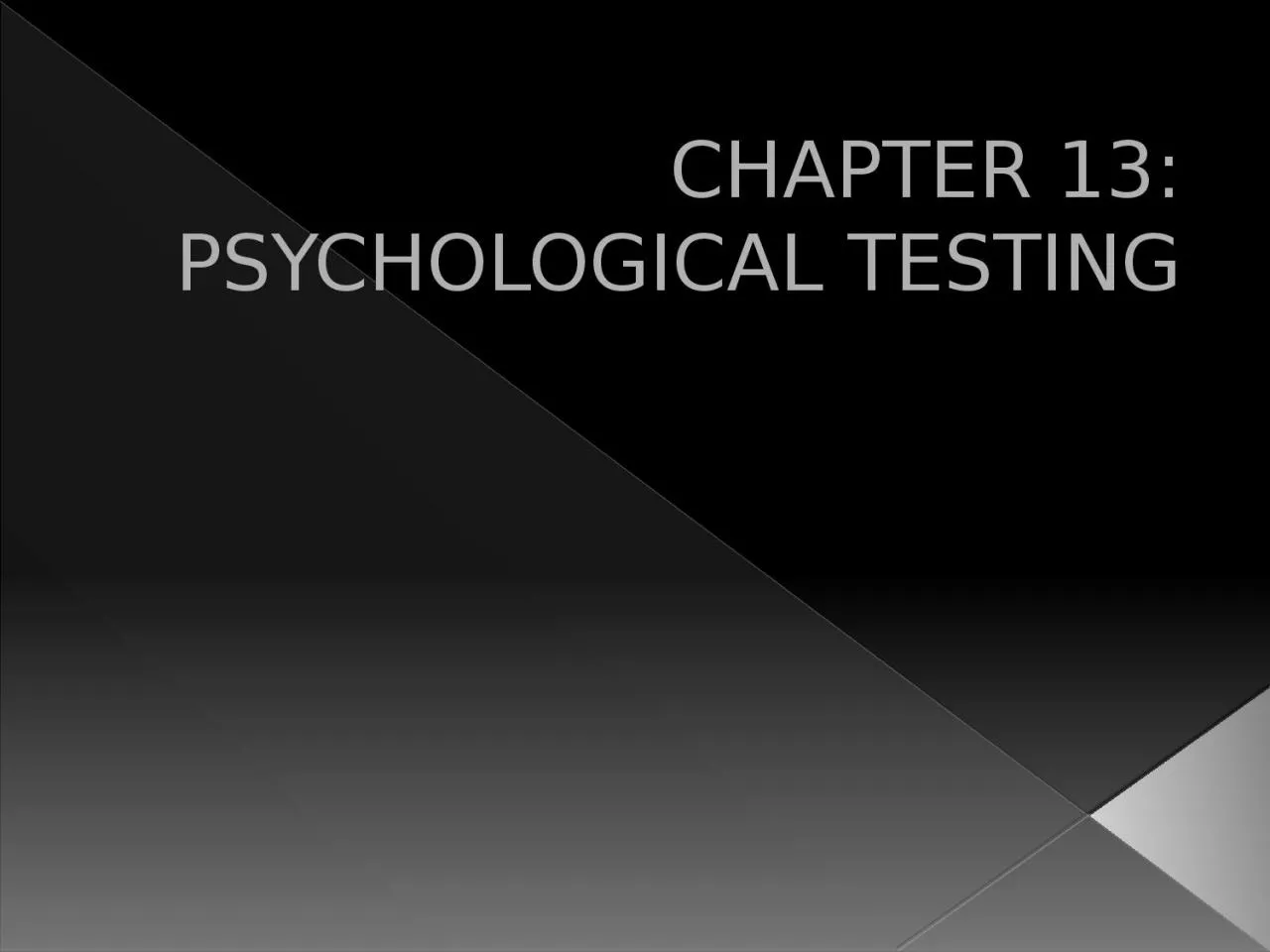

SECTION 1 CHARACTERISTICS OF PSYCHOLOGICAL TESTING TEST RELIABILITY Reliability ability of a test to give the same results under similar conditions 3 ways to determine 1 Retesting approx score must be maintained ID: 934641
Download Presentation The PPT/PDF document "CHAPTER 13: PSYCHOLOGICAL TESTING" is the property of its rightful owner. Permission is granted to download and print the materials on this web site for personal, non-commercial use only, and to display it on your personal computer provided you do not modify the materials and that you retain all copyright notices contained in the materials. By downloading content from our website, you accept the terms of this agreement.
Slide1
CHAPTER 13: PSYCHOLOGICAL TESTING
Slide2SECTION 1: CHARACTERISTICS OF PSYCHOLOGICAL TESTING
Slide3TEST RELIABILITY
Reliability
: ability of a test to give the same results under similar conditions
3 ways to determine:
1) Retesting: approx. score must be maintained
2) test yields same results from various people3) Split-half: divide test items in half and score each separately
Slide4TEST VALIDITY
Validity
: ability of a test to measure what it is intended to measure
Best way to measure validity:
predictive validity
(finding out afterwards)
Slide5STANDARDIZATION
Tests that are administered and graded in the same way
Must est. a norm (
avg
score) made by a large group
Slide6ESTABLISHING NORMS
Percentile system
: ranking of test scores that indicates the ratio of scores lower and higher than a given score
Norms
: standard of comparison for test results developed by giving the test to a large, well-defined group of people
Slide7SECTION 2: INTELLIGENCE TESTING
Slide8INTELLIGENCE
Def
: the ability to acquire new ideas and new behavior, and to adapt to new situations
Varying views…
Slide9TWO-FACTOR THEORY OF INTELLIGENCE
Charles Spearman
2 factors contribute to intelligence
1) g—general intelligence (complex mental work)
2) s—specific mental abilities (verbal/math)
Critics: g does not measure other mental abilities
Slide10THURSTONE’S THEORY OF INTELLIGENCE
L.L.
Thurstone
Opposed 2-factor theory
Proposed 7 primary mental abilities
Verbal comprehension, numerical ability, spatial relations, perceptual speed, word fluency, memory, inductive reasoning
Slide11GARDNER’S THEORY OF MULTIPLE INTELLIGENCES
Howard Gardner
8 types of intelligence
Verbal, logical/mathematic, spatial, musical, body-kinesthetic, interpersonal, intrapersonal, naturalist
Critics: most of these are skills, not intelligences
Slide12STERNBERG’S THEORY OF INTELLIGENCE
Robert Sternberg
Triarchic
Theory: intelligence can be divided into 3 ways of processing info
1)Analytical—problem solving
2)Creative—dealing with new things3)Practical—adjusting and coping with environment
Slide13EMOTIONAL INTELLIGENCE
Includes 4 major aspects of intra/interpersonal intelligences
1)accurately and appropriately perceive and express emotions
2) Uses emotions while thinking
Slide14EMOTIONAL INTELLIGENCE
3) Understand emotions and use the knowledge effectively
4) Regulate one’s emotions to promote personal growth
Slide15DEVELOPMENT OF INTELLIGENCE TESTS
Slide16STANFORD-BINET INTELLIGENCE SCALE
Groups test items by age level
Standardized
Intelligence Quotient (IQ)
: standardized measure of intelligence based on a scale in which 90-109 is average
Otis-Lennon Ability Test: measures cognitive abilities related to school
Slide17THE WECHSLER TESTS
Wechsler Adult Intelligence Scale (WAIS-R)
Wechsler Intelligence Scale for Children (WISC-III)—6-16
yr
olds
Wechsler Preschool and Primary Scales of Intelligences (WPPSI-R)—4-7 yr olds
Slide18CONTROVERSY OVER IQ TESTING
Slide19NATURE VS NURTURE
Identical twins have similar IQs
Those raised in the same environment have similar IQs
Both heredity and environment impact intelligence
Slide20CULTURAL BIAS
Def
: an aspect of an intelligence test in which wording in questions may be more familiar to people of one social group than to another group
Slide21SECTION 3: MEASURING ACHIEVEMENT, ABILITIES, AND INTERESTS
Slide22APTITUDE TESTS
Def
: estimates the probability that a person will be successful in learning a specific new skill
Assessed with
predictive validity
General Aptitude Test Battery (GATB)
: most widely used---9 different tests ranging from vocabulary to manual dexterity
SAT and ACT (American College Test): predict student’s success in college
Slide23ACHIEVEMENT TESTS
Def
: measures how much a person has learned in a given subject area
Assessed with
content validity
Adaptive testing: computer testing that responds to your performance
Slide24INTEREST INVENTORIES
Def
: measure of a person’s preferences and attitudes in a wide variety of activities to identify areas of likely success
Answer patterns will correspond with occupations
Kuder
Preference Record and the Campbell Interest and Skill Survey
Slide25SECTION 4: PERSONALITY TESTING
Slide26PERSONALITY TEST
Def
: assesses an individual’s characteristics and identifies problems
Some are objective and some are projective
Slide27OBJECTIVE TESTS
Def
: a limited-or-forced-choice test in which a person must select one of several answers
Slide28THE MMPI
Minnesota Multiphasic Personality Inventory
Answers reveal habits, fears, delusions, sexual attitudes, and symptoms of psych disorders
Best for diagnosing psych disorders
Slide29CPI
California Psychological Inventory
Measures traits like responsibility, self-control, and tolerance
Used to assess the “normal” person
Does NOT reveal psychiatric illnesses
Slide30MYERS-BRIGGS TEST
Focuses on how we take in info, make decisions, and approach day-to-day tasks
4 scales:
1) Extraversion v. Introversion
2) Intuition v. Sensing
3) Feeling v. Thinking 4) Judging v. PerceivingPersonality is a combination of these
Slide31PROJECTIVE TESTS
Def
: an unstructured test in which a person is asked to respond freely, giving his/her own interpretation of various ambiguous stimuli
Slide32RORSCHACH INKBLOT TEST
Best known and most widely discussed
Hermann Rorschach (1921)
Theory: A person’s response will reveal an aspect of that person’s personality
Slide33TAT
Thematic Apperception Test
Developed by Henry Murray (1943)
Participants are asked to tell a story about a picture (20 pictures total)
Used to assess motivation and personality characteristics